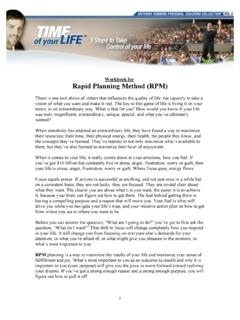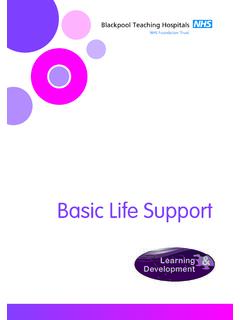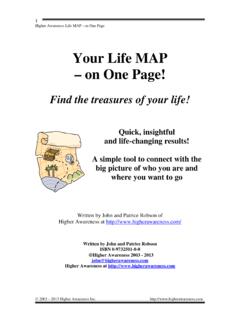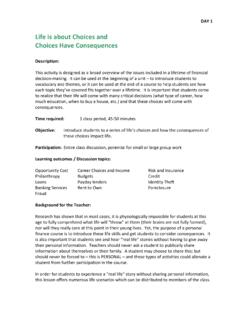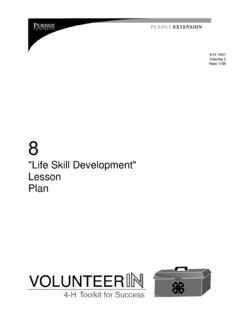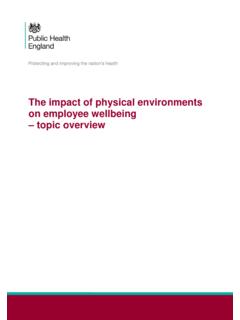Transcription of A Report from
1 P7P3P8P5P2P10P11P13P15P16 SCENICOVERLOOKP repare to Be Amazed by the Future of AgingWork More Years with More FlexibilityLearn Throughout LifeBuild Longevity- Ready CommunitiesInvest in Future Centenarians to Deliver Big ReturnsAlign Health Spans to life SpansLife Transitions Are a Feature, Not a BugThe Road AheadNOVEMBER 2021 SHAREROADAge Diversity is a Net Positive100 Years To ThriveROUTE100A Report from The Stanford Center on LongevityTHE NEW MAPLIFEof100 Years To ThriveIn the United States, demographers predict that as many as half of today s 5-year-olds can expect to live to the age of 100. By the middle of this century, this once unat-tainable milestone may become the norm for newborns, continuing a remarkable trend that saw human life expectancies double between 1900 and 2000, and still rising in this century, despite the grievous toll of the Covid-19 is one of the greatest achievements in human history, brought about by reductions in infant mortality, advances in sanitation and medicine, public education, and rising standards of living.
2 Yet the change came about so quickly that the social institutions, economic policies, and social norms that evolved when people lived for half as long are no longer up to the , iiWe see a huge opportunity. In 2018, the Stanford Center on Longevity launched an initiative called The New Map of life , believing that one of the most profound transformations of the human experience calls for equally momentous and creative changes in the ways we lead these longer lives. We make a clear distinction between aging, the biological process, and longevity, the measure of long life . The Center s goal is not to advocate for longer life a phenomenon that is well under-way rather, it is to identify ways to enhance the quality of those century-long lives, so that people experience a sense of belonging, purpose, and worth at all ages and advent of 100-year lives coincides with declin-ing birth rates, and these two defining demograph-ic trends are often conflated into a crisis narrative about an aging society about to be engulfed by a gray tsunami.
3 In this scenario, older adults are presumed to be a burden to society, and the presumed antidote to old people is more babies who, by historical standards, are becoming scarce. This crisis mindset assumes that people will age in the future as they did in the past, that financing 100-year lives is a challenge made insurmountable by the projected insolvency of the Social Security trust fund, and that additional mechanisms for saving, investing, and supplementing income are beyond reach. This static view of what it means to age distorts our perspectives about longevity in the future, and overlooks the opportunity to change the trajectory of aging and associated costs, by starting now to redesign institutions, practices, and norms so that they align with today s reality, rather than last century New Map of life calls on us to shift from a deficit mindset that laments the losses now associated with aging 2 The New Map of life 100 Years to Thrivewhether to health, mobility, financial security, independence, or social engagement and to identify the gains that now go unmeasured and overlooked.
4 In place of the outdated assumption that older adults drag down productivity and drain societal resources, we take a forward-facing perspective on the economic potential of a more age-diverse population in which older adults contribute in increasingly significant and measurable ways to the social good and to GDP, so that opportunities for healthy longevity are shared across races, geograph-ical regions, and socioeconomic these guiding principles, we set out to design The New Map of life to offer new, more flexible options for learning, earning, and saving, while also improving health and social engagement. To plot new options for the life course and its many variables, we created a postdoctoral training program and appointed an interdisciplinary team of talented fellows, each paired with a faculty mentor with expertise in nine domains that are core to longevity: early childhood, education, work, financial security, built environment, climate, health and technology, lifestyle and fitness, and intergenerational challenged the fellows to question the conven-tions and assumptions that are so baked into our age-defined culture we may not even recognize them or the ways in which they have limited our imaginations.
5 We find powerful evidence that lon-gevity holds even greater opportunities for growth than we thought possible when we launched our initiative. And we believe that the very real and substantial challenges that longevity creates for our economic and social order can be met if we act by the following principles, we can start laying the groundwork for a society that is healthi-er, more equitable, and Age Diversity is a Net PositiveNever before in human history have so many generations been alive at the same time, creating opportunities for intergenerational connection that have until now been life expectancy hovering around 30 years as recently as the 1800s, for much of human existence people had just enough time to pass on their genes and provide basic sustenance during their children s early years. Even by 1900, when life expectancy reached 47 years, only 6 percent 3 The New Map of life 100 Years to Thriveof American children had four living grandparents; by 2000, that figure had risen to 40 percent.
6 Today there are comparable numbers of people in every age group, from birth through their 70s, with increasing numbers in their 80s and era of unprecedented age diversity means so-ciety benefits from a complementarity of skills and abilities that people develop over their lives. The speed, strength, and zest for discovery common in younger people, combined with the emotional intelligence and experience prevalent among older people, create possibilities for families, communi-ties, and workplaces that haven t existed before. Having more older people means that children can receive more attention from grandparents or other caring adults. Multigenerational families can share financial and social resources, including housing and caregiving, deepening social responsibility and engagement across 2021 survey by the nonprofit organization Generations United found that one in four Americans were living in a household with three or more generations, and that multigenerational living has nearly quadrupled in the past decade.
7 Much of that surge can be attributed to the economic pressures of the pandemic: Nearly six in ten of those surveyed say they doubled or tripled up with family members due to a change in financial circumstances caused by the pandemic. Perhaps most interesting though, 72 percent of respondents say they plan to continue living in multigenerational households for the long term, citing benefits that include enhanced family bonds, greater ease of meeting the care needs of family members, improved mental and/or physical health, and improved finances or more time to continue school or job reap these as-yet unrealized benefits, we must bridge generations and reduce the age segregation that took hold in American society over the past century, as young people left family farms in search of higher-paying jobs and the population became concentrated in cities and suburbs designed for nuclear families.
8 Modernity and economic progress succeeded in delivering longer lives, but along the way, many Americans lost chances to share wisdom, joy, and everyday moments with extended family. Meanwhile, working parents struggle with stress-inducing gaps in caregiving, emotional support, and financial security. A key challenge ahead is to foster meaningful connections among different generations to take full advantage of social capital that humans have never before had diversity brings profound implications for the workforce as well. Workers over the age of 55 are the fastest-growing cohort, now comprising 25 percent of the workforce. While stereotypes portray older workers as less healthy, productive, and tech-savvy than their younger counterparts, the evidence suggests that older workers in knowledge jobs are superior in judgment, reliabil-ity, and mentoring skills and are indeed capable of mastering the technology requirements of their Along with an increased sense of compe-tence, older workers become motivated to use their vast repertoire of skills to help others.
9 All of these factors serve to improve workplace climate and reduce turnover among workers of all ages, thus lowering costs for ,viiWhile there are great variations in abilities and needs among people 65 and older, older people today are in better functional health than past gen-erations. Nonetheless, the 65+ demographic all 52 million of them are often lumped by marketers, media, and policymakers into a monolith assumed to represent a drain on society, rather than an 4 The New Map of life 100 Years to Thriveenormous, untapped source of human the narrative to value age diversity along with other forms of diversity is more than an exer-cise in semantics; it is essential if we are to make use of the immense reserves of knowledge, experi-ence, and skills in older adults who want to remain productive through paid work, volunteering, or mentoring, so that we can deploy them across the country at a time of tremendous need.
10 Misguided assumptions drive misguided employment policies, practices, and ageism. Rather than dwelling so anxiously on the costs incurred by an aging society, we should reframe the conversation around measuring and reaping the remarkable dividends of a society that is, in fact, Invest in Future Centenarians to Deliver Big Returns Aging society narratives portray the later decades of life as a period marked by vulnerability and longevity perspective instead views the 30 extra years of life as a dividend that can be strate-gically distributed across all stages of life . Mile-stones, expectations, and social norms will shift as a result. Must young people graduate from high school by 18 and hurtle across the educational finish line, diploma in hand by their early or mid 20s, to achieve success over a 100-year life ? Why not have learning be a lifelong pursuit that is just as likely to take place outside a real or virtual classroom as inside one?

